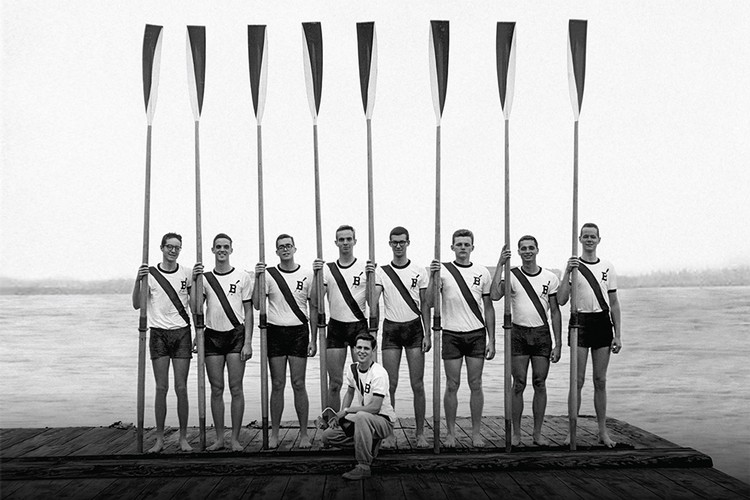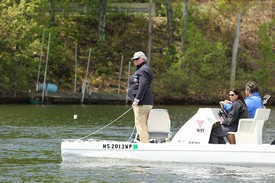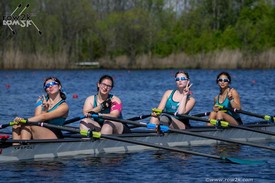
We had won the Dad Vail twice and now were lined up for the 1961 final with seven other crews. On one side was Amherst College whom we had left in a Connecticut River fog bank earlier in the season. Poor Amherst. The person driving their truck hit a telephone pole right there on Kelly Drive Philadelphia teeming with a hundred different crews. The collision broke the bow of their boat clean off. So we leant them the Stein.
Close by on the other side, adjacent, was Rollins College from Florida whose seven-man began to trash-talk.
"Hello Esch," he said. "Listen, we'll be ahead of you at the end of the racing start."
It was Jim McDermott with whom I used to run at the Hotchkiss School.
His words just mildly annoyed me but got through to our corresponding seven-man Marshmallow Basketball, one of the strongest persons in our boat.
On the second stroke of the race Marsh drove so hard with his legs that he "jumped his slide," i.e., his seat with wheels rose right off its track.
"Our time was faster than yours," a member of our jayvee crew recalled fifty-nine years later.
"I told you we'd be ahead of you at the end of the start and we were!" Jim McDermott would say at a Hotchkiss reunion.
Neither of these persons knew that Marsh jumped his slide, which would have been the end of the season for us except that Marsh was an engineer and figured out how to get his seat back on its track.
All the crews had left us. We passed the Philadelphia schools and some others and then Amherst and won by a length.
Amherst finished second, the best they've ever done. The Stein-- a fast boat!

Despite any disappointment, the publicity and implications of our summer of 1960 were vast. Sports Illustrated called Brown's IRA result "the biggest upset since David skulled Goliath." The New York Herald Tribune put this headline on a story by Irving T. Marsh: CAL WON THE REGATTA-- BROWN STOLE THE SHOW.
My own article on the race appeared in The Brown Daily Herald Supplement and Brown president Barnaby C. Keeney read it.
I was walking to class when a secretary came down from Brown's University Hall, tapped me on the shoulder and said, "President Keeney would like to speak with you."
Deciding to cut class, I climbed with her to the top of University Hall.
"Hello John," President Keeney said. "Tell me about the crew."
What I told him was similar to this book but shorter. At the end of the hour he told me that Brown crew would become a recognized sport.
As Bob Olson said of whatever he was referring to, "You need some background."
Within a week of our high-stroking club crew win at the 1959 Dad Vail I put together the first of several newsletters called "STROKE: The News of the Brown Rowing Association."
It wasn't as if I myself created a handsome three-toned woodcut masthead of brown, grey and black. No, I inherited it from the darker days of Brown Crew. And like a good Philistine for the subsequent issues I xeroxed it thus doing away with the beautiful grey, the ever so rich brown-- didn't look as good but was fast and cheap.

Without knowing anything about direct mail advertising/fund-raising and still feeling the flush of epic victory, I sprang for a full-out print job for that first issue.
My dad, who headed a direct mail educational publications business in New London, Connecticut, helped me lay out spectacular reprints from The Providence Journal and United Press International.
As a crew, we were lucky we only nipped Menlo Park by a length and all the Philadelphia schools and others were clustered close enough for a single angled photo that was breathtakingly dramatic yet told the whole story.
In addition my dad deliberately inserted the phrase "the Brown Cinderella crew" into my virgin solicitation for funds. And boy did that phrase through the help of the Providence Journal catch on nationally. A surprisingly large contingent of newspapers arose from nowhere to decide that they liked us.

One of the employees at my dad's business gave him the name, address and rumored identification of a Mr. Hunter Marston at nearby Watch Hill, Rhode Island.
And thus in a long and impecunious lifetime began my first and only attempt at fundraising. The "tip" my father received was that Mr. Marston, an executive of Continental Can Corporation, was a graduate of Brown.

"Dear Mr. Marston," I wrote, "As a graduate of Brown well known to be interested in sports, I thought you might like a copy of this newsletter."
That would be okay so long as we both understood that he was the graduate and I the undergraduate.
A few days afterward I received a long envelope from Mr. Marston and opened it in philosophy class. Bill Engeman and I were sitting in the last row of the Sage Hall lecture room. The professor of philosophy, curious if not disgruntled at the sudden commotion at the back of the room did not rush toward us as some grade school teacher might to snatch the envelope out of my hand. Clearly he was the sort of person who didn't need to know everything about everything.
The envelope contained a check for a thousand dollars made out to the Brown Rowing Association, "seed money" as one veteran of Brown fundraising would put it sixty years later.
Then came oars with a shell that Mr. Marston permitted me over the phone to name "Hunter."
While I never met Mr. Marston in person, Bill Engeman and I did drive to Watch Hill one day to pick up an old single shell hanging in Mr. Marston's spare shed.

I think my favorite experience as a student-athlete was a practice my freshman year, when I was still very new to the sport of rowing. This was a practice early in the spring season, and my boat was the first to launch, so we were alone on the Seekonk. It started to snow and we were warming up to Pawtucket on a silent, peaceful river. It was a rare moment of beauty in an otherwise quite industrial and somewhat neglected landscape.” -- Julia Lynn, Brown student in 2020
If you enjoy and rely on row2k, we need your help to be able to keep doing all this. Though row2k sometimes looks like a big, outside-funded operation, it mainly runs on enthusiasm and grit. Help us keep it coming, thank you! Learn more.
Comments | Log in to comment |
There are no Comments yet
| |
- Bont Rowing
- Calm Waters Rowing
- Concept 2
- Craftsbury Sculling
- The Crew Classic
- CrewLAB
- Croker
- Dad Vail Regatta
- Durham Boat Co.
- Empacher
- Faster Masters
- Filippi
- Fluidesign
- h2row.net
- HUDSON
- Live2Row Studios
- Nielsen-Kellerman
- Oak Ridge RA
- Peinert Boat Works
- Pocock Racing Shells
- Race1 USA
- Rockland Rowing Masters Regatta
- RowKraft
- Rubini Jewelers
- Vespoli USA
- WinTech Racing
- Bont Rowing
- Calm Waters Rowing
- Concept 2
- Craftsbury Sculling
- The Crew Classic
- CrewLAB
- Croker
- Dad Vail Regatta
- Durham Boat Co.
- Empacher
- Faster Masters
- Filippi
- Fluidesign
- h2row.net
- HUDSON
- Live2Row Studios
- Nielsen-Kellerman
- Oak Ridge RA
- Peinert Boat Works
- Pocock Racing Shells
- Race1 USA
- Rockland Rowing Masters Regatta
- RowKraft
- Rubini Jewelers
- Vespoli USA
- WinTech Racing

















